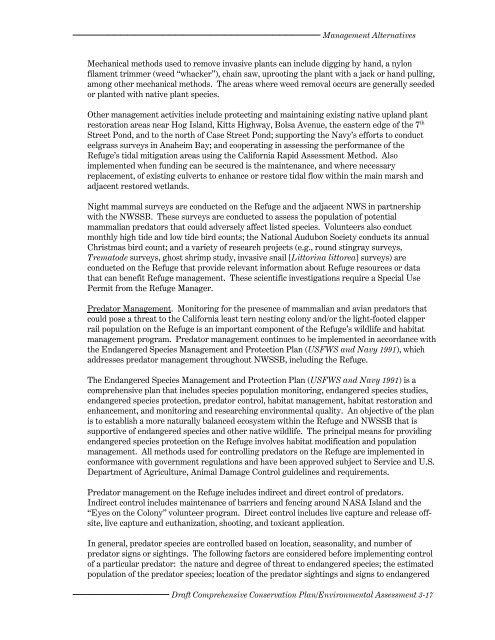Chapters 1 - U.S. Fish and Wildlife Service
Chapters 1 - U.S. Fish and Wildlife Service
Chapters 1 - U.S. Fish and Wildlife Service
Create successful ePaper yourself
Turn your PDF publications into a flip-book with our unique Google optimized e-Paper software.
Management Alternatives<br />
Mechanical methods used to remove invasive plants can include digging by h<strong>and</strong>, a nylon<br />
filament trimmer (weed “whacker”), chain saw, uprooting the plant with a jack or h<strong>and</strong> pulling,<br />
among other mechanical methods. The areas where weed removal occurs are generally seeded<br />
or planted with native plant species.<br />
Other management activities include protecting <strong>and</strong> maintaining existing native upl<strong>and</strong> plant<br />
restoration areas near Hog Isl<strong>and</strong>, Kitts Highway, Bolsa Avenue, the eastern edge of the 7 th<br />
Street Pond, <strong>and</strong> to the north of Case Street Pond; supporting the Navy’s efforts to conduct<br />
eelgrass surveys in Anaheim Bay; <strong>and</strong> cooperating in assessing the performance of the<br />
Refuge’s tidal mitigation areas using the California Rapid Assessment Method. Also<br />
implemented when funding can be secured is the maintenance, <strong>and</strong> where necessary<br />
replacement, of existing culverts to enhance or restore tidal flow within the main marsh <strong>and</strong><br />
adjacent restored wetl<strong>and</strong>s.<br />
Night mammal surveys are conducted on the Refuge <strong>and</strong> the adjacent NWS in partnership<br />
with the NWSSB. These surveys are conducted to assess the population of potential<br />
mammalian predators that could adversely affect listed species. Volunteers also conduct<br />
monthly high tide <strong>and</strong> low tide bird counts; the National Audubon Society conducts its annual<br />
Christmas bird count; <strong>and</strong> a variety of research projects (e.g., round stingray surveys,<br />
Trematode surveys, ghost shrimp study, invasive snail [Littorina littorea] surveys) are<br />
conducted on the Refuge that provide relevant information about Refuge resources or data<br />
that can benefit Refuge management. These scientific investigations require a Special Use<br />
Permit from the Refuge Manager.<br />
Predator Management. Monitoring for the presence of mammalian <strong>and</strong> avian predators that<br />
could pose a threat to the California least tern nesting colony <strong>and</strong>/or the light-footed clapper<br />
rail population on the Refuge is an important component of the Refuge’s wildlife <strong>and</strong> habitat<br />
management program. Predator management continues to be implemented in accordance with<br />
the Endangered Species Management <strong>and</strong> Protection Plan (USFWS <strong>and</strong> Navy 1991), which<br />
addresses predator management throughout NWSSB, including the Refuge.<br />
The Endangered Species Management <strong>and</strong> Protection Plan (USFWS <strong>and</strong> Navy 1991) is a<br />
comprehensive plan that includes species population monitoring, endangered species studies,<br />
endangered species protection, predator control, habitat management, habitat restoration <strong>and</strong><br />
enhancement, <strong>and</strong> monitoring <strong>and</strong> researching environmental quality. An objective of the plan<br />
is to establish a more naturally balanced ecosystem within the Refuge <strong>and</strong> NWSSB that is<br />
supportive of endangered species <strong>and</strong> other native wildlife. The principal means for providing<br />
endangered species protection on the Refuge involves habitat modification <strong>and</strong> population<br />
management. All methods used for controlling predators on the Refuge are implemented in<br />
conformance with government regulations <strong>and</strong> have been approved subject to <strong>Service</strong> <strong>and</strong> U.S.<br />
Department of Agriculture, Animal Damage Control guidelines <strong>and</strong> requirements.<br />
Predator management on the Refuge includes indirect <strong>and</strong> direct control of predators.<br />
Indirect control includes maintenance of barriers <strong>and</strong> fencing around NASA Isl<strong>and</strong> <strong>and</strong> the<br />
“Eyes on the Colony” volunteer program. Direct control includes live capture <strong>and</strong> release offsite,<br />
live capture <strong>and</strong> euthanization, shooting, <strong>and</strong> toxicant application.<br />
In general, predator species are controlled based on location, seasonality, <strong>and</strong> number of<br />
predator signs or sightings. The following factors are considered before implementing control<br />
of a particular predator: the nature <strong>and</strong> degree of threat to endangered species; the estimated<br />
population of the predator species; location of the predator sightings <strong>and</strong> signs to endangered<br />
Draft Comprehensive Conservation Plan/Environmental Assessment 3-17

















